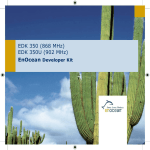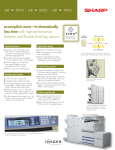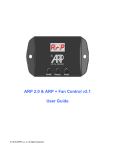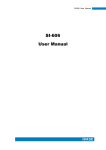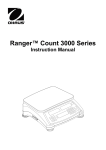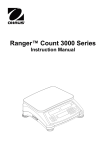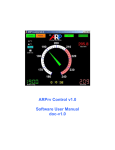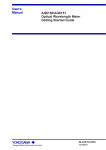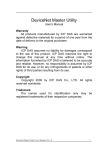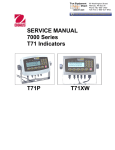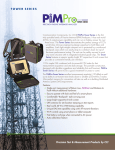Download MADA-2 Manual - Forssell Technologies
Transcript
F(t) Forssell Technologies Inc MADA-2 2 Channel Analog to Digital and Digital to Analog Converter User Manual 72311 General Description: The Forssell Technologies MADA-2 is an extremely high quality two channel Analog to Digital Converter (ADC) and two channel Digital to Analog Converter (DAC) housed in a 1U rack mount enclosure. The MADA-2 can be powered from 115 or 230 volt 50/60 Hz line voltages. An internally mounted switch selects which line voltage can be used. The MADA-2 has AES3 and SPDIF digital inputs and outputs, as well as a Word Clock input and output. Analog inputs and outputs are balanced and floating so that they can used with either balanced or unbalanced signals. Using the MADA-2 with unbalanced analog signal sources will result is slightly worst distortion figures when compared with a balanced analog signal source. No such compromise in performance exists for the analog outputs. Analog to Digital (ADC) Section Description: The ADC section of MADA-2 is a high quality two channel Analog to Digital Converter. The MADA2 is designed for the most demanding applications, where capturing musical performances with accuracy and honesty is required. Output sample rates from 44.1k to 192k Fs are selected with a single front panel switch and with LED indicators showing the selected sample rate. Digital “clipping” is indicated with a single front panel LED that latches on until the “reset” switch is pressed. The MADA-2 analog circuitry features an all Class A discrete JFET with no IC opamps used in the signal path. The analog inputs use high quality XLR connectors. The digital outputs provided are AES3 (XLR), SPDIF (RCA), WC Sync input and Word Clock output (BNC) are provided. An additional Word Clock output is available as an option. The MADA-2 digital output word length is fixed at 24 bits. The MADA-2 uses a 32 bit asynchronous decimation filter to provide various standard output sample rates from 44.1K to 192k. The actual low jitter sampling clock that controls the AD converter chip timing is permanently set to sample at 196.3 kFs regardless of output sampling rate selection. This process is called Asynchronous Sample Rate Conversion (ASRC) and is performed by a 32 bit sample rate converter. The output from the ASRC circuitry is 24 bit at the selected output sample rate. Please note that there are no provisions for word length reduction, or level metering with this converter. Word Clock Output: The MADA-2 has a single low jitter word clock output available on a rear panel mounted BNC connector. This output is designed to operate into a 75 ohm terminated coaxial cable. The output voltage is TTL compatible. The WC output follows the output sample rate, as selected by the front panel control. Additional WC outputs are provided on the MADA board, but the user would have to install their own connectors and wire them to the MADA board. Output Sample Rate selection: The output sample rate of the MADA-2 is selected by the single front panel mounted “Select” switch. The LEDs to the right of this switch indicate the output sample rate currently selected. The MADA-2 does not remember this setting when power is removed. If your sample rate is other than 44.1k, then you must reset the output sample rate to the desired sample rate each time the unit is powered up. “Over” LED: The front panel mounted red “Over” LED lights when any channel reaches a digital signal level that is within 0.1 dB of digital full scale for more than two sample periods. Once lighted, the over LED will remain lighted until the “reset” switch is press. The reset switch only effects the “Over” LED and does not reset the converter digital circuitry nor does it change the sample rate back to power up defaults. Each time you power up the MADA-2, the “Over” LED will light up. Press the reset switch to turn-off the Over LED. External Sync Input: Your MADA-2 is supplied with an External Word Clock Sync function External Sync is selected by pressing the “Select” switch until the WC external sync LED is lighted. If no valid WC is detected at the WC Input BNC connector, then the red SYNC LED will be lighted. Once a valid WC is applied to the BNC connector, the red LED will turn off, indicating that the MADA is locked to the external WC. The MADA-2 should lock within one second of receiving a valid WC sync input signal. A wide range of WC input frequencies can be used, including vari-speed WC signals. The WC sync input level should be TTL compatible and needs to be terminated with a 75 ohm resistor. The MADA-2 WC input is a high impedance input. This allows several units to be feed sync input with from one single WC source. To daisy-chain several units, you will need to use BNC Tee connectors on each unit. A 75 ohm terminator should be connected at the Tee connector of the very end of the chain. Analog Inputs: Analog inputs are provided on rear panel mounted XLR connectors. The MADA-2 can accept either balanced or unbalanced input signals. Unbalanced signals result in a 6 dB lower headroom. The XLR connectors are wired for pin #2 = + input, and pin #3 = - input signal polarities. The input impedance of analog inputs is approximately 3k ohm balanced. Level Calibration: Unless otherwise requested when your unit was ordered, the MADA-2 is calibrated so that a 0 (775 mv) dBu analog input level produces –18 dBFs digital output level. There are four sets of jumpers located on the MADA board inside the MADA-2 that will allow you to change the level calibration for the AD section. All four jumpers must be set for the same level calibration. Digital Outputs: There are two digital outputs available with the MADA-2. One is an AES/EBU (AES3) 110 ohm digital output on a rear mounted XLR connector. The other is a 75 ohm SPDIF digital output on a rear mounted RCA connector. These digital outputs are isolated from each other and they may be used simultaneously. Digital to Analog (DAC) Section Description: The DAC section MADA-2 is designed for the most demanding applications, where capturing musical performances with accuracy and honesty is required. The MADA-2 accepts digital inputs with sample rates from 44.1k to 192k Fs. The MADA-2 has AES3 (AES/EBU) 110 ohm on an XLR connector and SPDIF 75 ohm RCA inputs. Input selection is via a front panel push button switch with LED indicators showing which input is selected. Other front panel LED indicators show input fault condition and SCR lock status. Level Calibration: Unless otherwise requested when your unit was ordered, the MADA-2 is calibrated so that a -18 dBFS digital input level produces a 0 dBu (775 mV) analog output level. There are two trim pots located on the MDAC board inside the MADA-2 that will allow you to change the level calibration for the DA section. Digital inputs There are two digital inputs on the MADA-2. One is configured as an AES-3 or AES/EBU input, and the other is an SPDIF input. The AES-3 input is a 110 ohm, transformer isolated, and balanced XLR input. Pin #1 of this input is connected to chassis ground through a 0.1 mfd capacitor . The SPDIF input is a 75 ohm single-ended RCA input. Analog Outputs The analog output of the MADA-2 are balanced and floating with an output impedance of less than 5 ohms. Either balanced or single-ended loads may be connected to the output of the MADA-2 without problem. When a single-ended load (unbalanced) is used, be sure to take the signal between pin #2 (hot) and pin #3 (cold) of the input XLR. Pin #1 can be connected to either of these pins if desired. Connecting pin #1 to pin #2 will produce an output signal that is out of phase, so normally pin #1 is connected to pin #3 for single-ended loads. Pin #1 can be left floating too. MADA-2 Specifications: ADC specifications: Sample Rates available : 44.1k, 48k, 88.2k, 96k, 176.4k and 192k Level Calibration : 0 dBu Input = -18 dBFs (Other calibration levels available on request.) Analog Input Impedance = greater than 10k ohm balanced Maximum analog input level is a function level calibration (no analog clipping). AES3 (XLR) digital output impedance = 110 ohm balanced floating SPDIF (RCA) digital output impedance = 75 ohm balanced floating WC output = +5V (TTL) unterminated. Requires 75 ohm load termination at load. ADC Latency (Input to Output group delay): Fs 44.1k 48k 88.2k 96k 176k 192k Time 1.6 ms 1.48 ms 967 us 895 us 660 us 605 us DAC Specifications: Noise <= -120 dBFs A-weighted Quantization Noise <= -117 dBFs 400 to 22 KHz unweighted Dynamic Range > = 123 dB THD+N (%) = 0.0009% @ 1Khz 0 dBu output (-18 dBFs input) 600 ohm load THD+N (%) = 0.001% @ 1Khz +18 dBu output (0 dBFS input) 600 ohm load IMD (SMPTE) = 0.001% @ 0 dBu output (-18 dBFs input) 600 ohm load IMD (SMPTE) = 0.003% @ +18 dBu output (0 dBFs input) 600 ohm load DAC Latency Fs 44.1k 48k 88.2k 96k 176k 192k Time 1.97 ms 1.8 ms 1.13 ms 665 us 712 us 678 us Analog in to Analog Output Specifications: Noise Floor = -96 dBu unweighted 22 to 22 KHz THD+N (%) = 0.001 % with 1Khz 0 dBu input/outout (-18 dBFs) THD+N (%) = 0.008 %Fs with 1Khz +18 dBu input/output (0 dBFS) IMD (SMPTE) = 0.002% with 0 dBu input/output (-18 dBFs) IMD (SMPTE) = 0.05% with +18 dBu input/output (0 dBFs) General Specifications: Power consumption = 14 watts @ 120 VAC AC Line Voltage range = 110 to 125 VAC and 220 to 250 VAC 50 or 60 Hz AC Line Voltage: The MADA come preset for either 115 VAC or 230 VAC 50/60 Hz operation as indicted by a rear panel label. The line voltage is selected by a line voltage switch mounted inside the MADA chassis. Changing the line voltage from the factory setting requires a change to the AC line fuse which is located within the AC power entry module on the rear panel. You must use one of the following fuse values… 115 VAC use 250 milliamp TD fuse. 230 VAC use 100 milliamp TD fuse. Line voltage changes should only be made by a qualified technician. DAC Measurements +0 -5 -10 -15 -20 -25 -30 -35 -40 -45 -50 -55 -60 d B u -65 -70 -75 -80 -85 -90 -95 -100 -105 -110 -115 -120 -125 -130 -135 -140 2k 4k 6k 8k 10k 12k 14k 16k 18k 20k 22k 24k 26k 28k 30k 32k Hz D-A FFT HiRes Stereo.at2c DA FFT (linear scale) of 2 KHz signal at 0 dBu output level with a 600 load. Red = Ch1 Blue= Ch2 +0 -5 -10 -15 -20 -25 -30 -35 -40 -45 -50 -55 -60 d B u -65 -70 -75 -80 -85 -90 -95 -100 -105 -110 -115 -120 -125 -130 -135 -140 20 50 100 200 500 1k 2k 5k 10k 20k Hz D-A FFT HiRes Stereo.at2c DA FFT (log scale) 2 KHz signal at 0 dBu output level with a 600 load. Red = Ch1 Blue= Ch2 30k +0 -5 -10 -15 -20 -25 -30 -35 -40 -45 -50 -55 -60 d B u -65 -70 -75 -80 -85 -90 -95 -100 -105 -110 -115 -120 -125 -130 -135 -140 2k 4k 6k 8k 10k 12k 14k 16k 18k 20k 22k 24k 26k 28k 30k 32k 20k 30k Hz D-A FFT HiRes Stereo.at2c DA FFT (linear scale) 2 KHz signal at -100 dBu output level. Red = Ch1 Blue= Ch2 +0 -5 -10 -15 -20 -25 -30 -35 -40 -45 -50 -55 -60 d B u -65 -70 -75 -80 -85 -90 -95 -100 -105 -110 -115 -120 -125 -130 -135 -140 20 50 100 200 500 1k 2k 5k 10k Hz D-A FFT HiRes Stereo.at2c DA FFT (log scale) of 2 KHz signal at -100 dBu output level with a 600 load. Red = Ch1 Blue= Ch2 +0 -5 -10 -15 -20 -25 -30 -35 -40 -45 -50 -55 -60 d B u -65 -70 -75 -80 -85 -90 -95 -100 -105 -110 -115 -120 -125 -130 -135 -140 2k 4k 6k 8k 10k 12k 14k 16k 18k 20k 22k 24k 26k 28k 30k 32k 20k 30k Hz D-A FFT HiRes Stereo dual freq.at2c DA FFT (linear scale) of Dual Freq (19 and 19.5 KHz) signal at 0 dBu Output Level. +0 -5 -10 -15 -20 -25 -30 -35 -40 -45 -50 -55 -60 d B u -65 -70 -75 -80 -85 -90 -95 -100 -105 -110 -115 -120 -125 -130 -135 -140 20 50 100 200 500 1k 2k 5k Hz D-A FFT HiRes Stereo dual freq.at2c DA FFT (log scale) of Dual Freq (19 and 19.5 KHz) signal at 0 dBu Output Level. 10k +1 +0.8 +0.6 +0.4 +0.2 +0 -0.2 -0.4 -0.6 d B r A -0.8 -1 -1.2 -1.4 -1.6 -1.8 -2 -2.2 -2.4 -2.6 -2.8 -3 10 20 50 100 200 500 1k 2k 5k 10k 20k 40k Hz D-A FREQ RESP.at2c DA Frequency Response at 96 KHz sample Rate +0 -10 -20 -30 -40 -50 -60 d B r -70 A -90 -80 -100 -110 -120 -130 -140 -150 -160 20 50 100 200 500 1k 2k 5k 10k 20k Hz D_A Jitter Spectrum 0.at27 DA Jitter FFT (44.1k Fs) with 1 KHz 0 dBFs sine wave signal and 500 Hz sine wave jitter at 1 UI (177 ns) amplitude +3 +15 +2.8 +10 +2.6 +5 +2.4 +0 +2.2 +2 -5 +1.8 -10 +1.6 -15 +1.4 -20 +1.2 -25 +1 -30 +0.8 -35 +0.6 +0.4 -40 d B u +0.2 -45 +0 -50 -0.2 -55 -0.4 -60 -0.6 -65 -0.8 d B r A -1 -70 -1.2 -75 -1.4 -80 -1.6 -85 -1.8 -90 -2 -95 -2.2 -100 -2.4 -2.6 -105 -2.8 -110 -130 -120 -110 -100 -90 -80 -70 -60 -50 -40 -30 -20 -10 +0 dBFS D-A LINEARITY.at2c Deviation from Linearity (Right scale) with 0 dBFs to –130 dBFs (Input). ADC Measurements -20 -25 -30 -35 -40 -45 -50 -55 -60 -65 -70 -75 -80 d B F S -85 -90 -95 -100 -105 -110 -115 -120 -125 -130 -135 -140 -145 -150 -155 -160 1k 2k 3k 4k 5k 6k 7k 8k 9k 10k 11k 12k 13k 14k 15k Hz A-D FFT.at2c AD FFT (linear scale) with 0 dBu 5 KHz input (-18 dBFs digital output). 16k 17k 18k 19k 20k 21k 22k -20 -25 -30 -35 -40 -45 -50 -55 -60 -65 -70 -75 -80 d B F S -85 -90 -95 -100 -105 -110 -115 -120 -125 -130 -135 -140 -145 -150 -155 -160 20 50 100 200 500 1k 2k 5k 10k 20k Hz A-D FFT.at2c AD FFT (log scale) with 0 dBu 5 KHz input (-18 dBFs digital output). -20 -25 -30 -35 -40 -45 -50 -55 -60 -65 -70 -75 -80 d B F S -85 -90 -95 -100 -105 -110 -115 -120 -125 -130 -135 -140 -145 -150 -155 -160 2.5k 5k 7.5k 10k 12.5k 15k 17.5k 20k 22.5k 25k 27.5k 30k 32.5k 35k Hz A-D FFT Dual Freq.at2c AD FFT (linear scale) with dual frequency (19 and 19.5 KHz) 0 dBu signal 37.5k 40k 42.5k 45k 47.5k -20 -25 -30 -35 -40 -45 -50 -55 -60 -65 -70 -75 -80 d B F S -85 -90 -95 -100 -105 -110 -115 -120 -125 -130 -135 -140 -145 -150 -155 -160 20 50 100 200 500 1k 2k 5k 10k 20k 40k 10k 20k 40k Hz A-D FFT Dual Freq.at2c AD FFT (log scale) with dual frequency (19 and 19.5 KHz) 0 dBu signal +1 +0.8 +0.6 +0.4 +0.2 +0 -0.2 -0.4 -0.6 d B r 1 -0.8 -1 -1.2 -1.4 -1.6 -1.8 -2 -2.2 -2.4 -2.6 -2.8 -3 20 50 100 200 500 1k 2k 5k Hz A-D FREQ RESP.at2c AD High Frequency Response at 44.1k, 48k, 88.2k, and 96k. (96k is the limit of the test equipment) +3 +2.8 +2.6 +2.4 +2.2 +2 +1.8 +1.6 +1.4 +1.2 +1 +0.8 +0.6 +0.4 d B r 1 +0.2 +0 -0.2 -0.4 -0.6 -0.8 -1 -1.2 -1.4 -1.6 -1.8 -2 -2.2 -2.4 -2.6 -2.8 -3 10 20 50 100 200 500 1k Hz AD Low Frequency Freq Resp +0 +3 +2.8 -5 +2.6 -10 +2.4 -15 +2.2 -20 +2 -25 +1.8 -30 +1.6 -35 +1.4 -40 +1.2 +1 -45 +0.8 -50 +0.6 -55 d B F S +0.4 -60 +0.2 -65 +0 -70 -0.2 -0.4 -75 -0.6 -80 -0.8 -85 -1 -90 -1.2 -95 -1.4 -100 -1.6 -105 -1.8 -2 -110 -2.2 -115 -2.4 -120 -2.6 -125 -130 -2.8 -110 -100 -90 -80 -70 -60 -50 -40 -30 -20 dBu A-D LINEARITY2.at2c Deviation from Linearity (Right scale) from 0 dBFs to –130 dBFs Output -10 +0 +10 -3 d B F S Analog In, Analog Out Measurements +1 T +0.8 +0.6 +0.4 +0.2 +0 -0.2 -0.4 -0.6 d B r A -0.8 -1 -1.2 -1.4 -1.6 -1.8 -2 -2.2 -2.4 -2.6 -2.8 10 20 50 100 200 500 1k 2k 5k 10k 20k 50k 100k Hz Freq Resp Lo.at2c MADA-2 Freq Resp at 44.1k, 48k, 88.2k, 96k, 176.2k, 196k Sample Rates +0 -5 -10 -15 -20 -25 -30 -35 -40 -45 -50 -55 -60 d B u -65 -70 -75 -80 -85 -90 -95 -100 -105 -110 -115 -120 -125 -130 -135 -140 2k 4k 6k 8k 10k 12k 14k 16k 18k 20k 22k Hz Mic Pre FFT.at2c Analog to Analog FFT (linear scale) 96k Sample Rate 0 dBu Input/Output 24k 26k 28k 30k 32k +0 -5 -10 -15 -20 -25 -30 -35 -40 -45 -50 -55 -60 d B u -65 -70 -75 -80 -85 -90 -95 -100 -105 -110 -115 -120 -125 -130 -135 -140 10 20 50 100 200 500 1k 2k 5k 10k 20k 30k Hz Mic Pre FFT.at2c Analog to Analog FFT (log scale) 96k Sample Rate 0 dBu Input/Output (-18 dBFs) +0 -5 -10 -15 -20 -25 -30 -35 -40 -45 -50 -55 -60 d B u -65 -70 -75 -80 -85 -90 -95 -100 -105 -110 -115 -120 -125 -130 -135 -140 2k 4k 6k 8k 10k 12k 14k 16k 18k 20k 22k 24k 26k 28k Hz Mic Pre FFT.at2c Analog to Analog FFT (linear scale) 96k Sample Rate +18 dBu Input/Output ( 0 dBFs) 30k 32k +0 -5 -10 -15 -20 -25 -30 -35 -40 -45 -50 -55 -60 d B u -65 -70 -75 -80 -85 -90 -95 -100 -105 -110 -115 -120 -125 -130 -135 -140 2k 4k 6k 8k 10k 12k 14k 16k 18k 20k 22k 24k 26k 28k 30k 32k 30k 32k Hz Mic Pre FFT.at2c Analog to Analog FFT (linear scale) 96k Sample Rate -100 dBu Input/Output (-118 dBFs) +0 -5 -10 -15 -20 -25 -30 -35 -40 -45 -50 -55 -60 d B u -65 -70 -75 -80 -85 -90 -95 -100 -105 -110 -115 -120 -125 -130 -135 -140 2k 4k 6k 8k 10k 12k 14k 16k 18k 20k 22k 24k 26k Hz A-A FFT Dual Tone.at2c A-A FFT (linear scale) with dual frequency (19 and 19.5 KHz) 0 dBu output signal 28k +0 -5 -10 -15 -20 -25 -30 -35 -40 -45 -50 -55 -60 d B u -65 -70 -75 -80 -85 -90 -95 -100 -105 -110 -115 -120 -125 -130 -135 -140 10 20 50 100 200 500 1k 2k 5k 10k 20k 30k Hz A-A FFT Dual Tone.at2c A-A FFT (linear scale) with dual frequency (19 and 19.5 KHz) 0 dBu output signal +1 +0.8 +0.6 +0.4 +0.2 +0 -0.2 -0.4 -0.6 -0.8 d B u -1 -1.2 -1.4 -1.6 -1.8 -2 -2.2 -2.4 -2.6 -2.8 -3 20 50 100 200 500 1k 2k Hz Freq Resp Lo.at2c A-A Frequency Response showing –3 dB response at 96k Fs 5k 10k 20k 60k +0 -5 -10 -15 -20 -25 -30 -35 -40 d B u -45 -50 -55 -60 -65 -70 -75 -80 -85 -90 20 50 100 200 500 1k Hz Freq Resp Lo.at2c A-A Frequency Response showing full response at 96k Fs 2k 5k 10k 20k 60k Word Clock Jitter Measurements Measured at WC output BNC at 96 KHz sample rate Measurement calibration is… 1 millivolt = 100 picoseconds pk-pk jitter. 100 microvolt= 10 picoseconds pk-pk. For peak jitter, divide by 2. For RMS multiply by 0.3535 2m 1.9m 1.8m 1.7m 1.6m 1.5m 1.4m 1.3m 1.2m 1.1m V 1m .9m 800u 700u 600u 500u 400u 300u 200u 100u 600 700 800 900 1k 2k 3k 4k 5k 6k 7k 8k 9k 10k 20k Hz Jitter signal extracted from the WC output of MADC-2 measured with swept bandpass filter. Blue trace is using internal oscillator, Red is synced to WC input. Spot Jitter for internal oscillator is 40 ps pk-pk, 20 ps peak, or 14 ps rms maximum. Spot Jitter of external WC sync is 130 ps pk-pk, 65 ps peak, or 46 ps rms maximum. 1m .95m .9m 850u 800u 750u 700u 650u 600u 550u V 500u 450u 400u 350u 300u 250u 200u 150u 100u 50u 1k 2k 3k 4k 5k 6k 7k 8k 9k 10k 11k 12k 13k 14k 15k 16k 17k 18k 19k Hz FFT (linear scale) of extracted jitter signal. Red = internal osc, Blue external sync 20k 3m 2.9m 2.8m 2.7m 2.6m 2.5m 2.4m 2.3m 2.2m 2.1m 2m 1.9m 1.8m 1.7m 1.6m V 1.5m 1.4m 1.3m 1.2m 1.1m 1m .9m 800u 700u 600u 500u 400u 300u 200u 100u 20 50 100 200 500 1k 2k 5k 10k 20k Hz FFT (log scale) of extracted jitter signal. Red = internal osc, Blue external sync. Note… due to measurement technique, jitter figures below 1 KHz may not be entirely accurate.




















